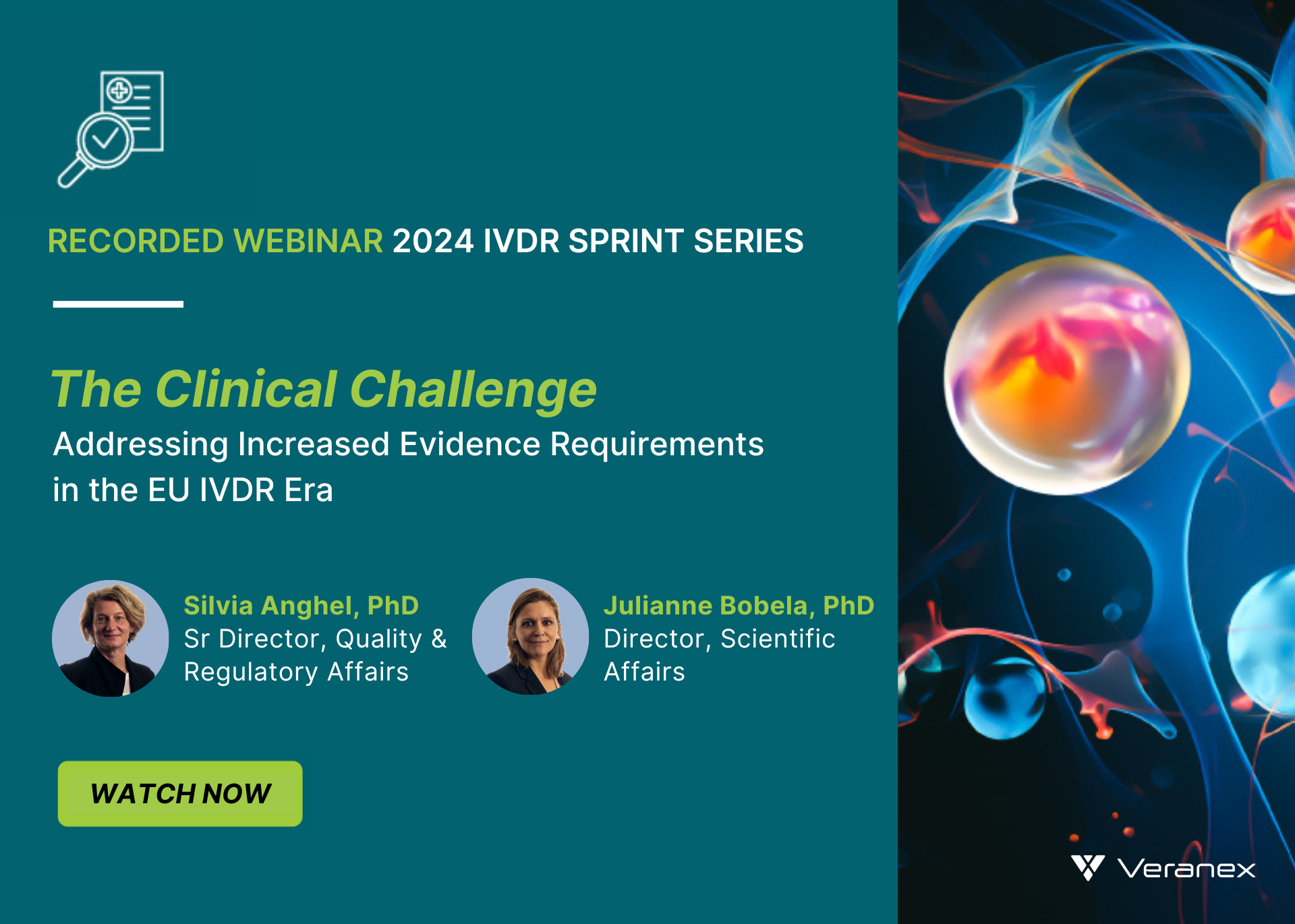
In accordance with Article 5(3) of Regulation (EU) 2017/746 (IVDR), a performance evaluation must be drawn up for every IVD placed on the European market, regardless of the device’s risk class (Yes, even class A devices require a proper performance evaluation!).
As defined in Article 2(44) of the IVDR this is an “assessment and analysis of data to establish or verify the scientific validity, the analytical and, where applicable, the clinical performance of a device,” thus demonstrating the device’s compliance with the relevant General Safety and Performance Requirements (GSPR), including a positive benefit-risk ratio. The performance evaluation is based on a continuous process and follows a defined and methodologically sound procedure, taking into consideration the established device-specific plan, i.e., the Performance Evaluation Plan (PEP). The identified performance and safety data is then consolidated in the Performance Evaluation Report (PER). These two documents form part of the device’s technical file and are reviewed by the Notified Body during the conformity assessment procedure.
De facto, IVD manufacturers will need to invest resources in evaluating the performance of their devices prior to undergoing a conformity assessment under IVDR. A few points presented below illustrate why it’s always a good idea to start the performance evaluation process as early as possible.
Thanks to its extensive IVD expertise, Veranex can help you with this process by:
- Establishing the device’s state of the art through a methodological search of the literature, and based on the state of the art assessment, determine the relevant performance and safety parameters and their respective acceptance criteria needed to assess the risk-benefit ratio of your IVD
- Documenting the device’s scientific validity
- Ensuring that your device complies with all relevant analytical performance requirements
- Assessing all available sources of clinical performance data to determine if a clinical performance study is required
- Assess whether the available clinical evidence allows you to substantiate all performance and safety claims you wish to make about your device for marketing purposes
- Implementing PEP and PER documentation in accordance with IVDR and the latest views of Notified Bodies
The Benefits of Starting Early with the Performance Evaluation Process

1. It ensures alignment with the current “state of the art”
In accordance with the requirements of the Regulation (Annex XIII), a PEP must include, “a description of the state of the art, including an identification of existing relevant standards, Common Specifications, guidance or best practices documents.”
Establishing a PEP early on in the design and development phase can guide design choices that are representative of the current state of the art. State of the art assessment also enables risk control measures to be aligned with current safety principles, and analytical performance tests to be carried out in line with the latest applicable guidelines. For legacy devices transitioning to IVDR, this process enables assessing whether the device remains in line with the current state of the art and facilitates defining the appropriate performance and safety parameters and their acceptance criteria needed to determine the acceptability of the device’s benefit-risk ratio in line with IVDR requirements.
Establishing the state of the art is therefore one of the first steps in preparing a performance evaluation. Furthermore, as the state of the art relating to an IVD may evolve over time, manufacturers are expected to regularly review and evaluate its evolution throughout the device’s lifecycle, to determine how it affects the performance evaluation outcomes and the device’s benefit-risk ratio.
2. It allows for an early assessment of the level of clinical evidence required
The level of clinical evidence needed to fully demonstrate the performance and safety of the device as claimed by the manufacturer will depend on the characteristics of the device and its intended use. Manufacturers transitioning their devices to IVDR shall assess as soon as possible the level of clinical evidence required. This includes verifying that all performance and safety claims, including those used for marketing purposes, are supported by an adequate level of evidence. Doing so will either allow for timely follow-up actions to collect additional performance data in case some claims are not yet sufficiently supported by clinical evidence, or to reword the device’s intended use taking into consideration the existing clinical evidence.
3. It helps to identify and react to gaps in the analytical performance
Conducting a performance evaluation in advance will allow the manufacturer to identify gaps in the data supporting the analytical performance of the device in a timely manner. If gaps are identified, the manufacturer will be able to generate new evidence in accordance with common specifications, guidelines, or applicable standards, to demonstrate that the IVD in question is capable of reliably, accurately, and consistently detecting the analyte, and thus GSPRSs linked to the analytical features of the device are adequately addressed.
4. It determines if sufficient clinical performance data is available
It is also important to promptly determine whether sufficient clinical performance data is available to support the intended use of the device, as well as the claimed indications. The level of clinical evidence should be consistent with the clinical strategy defined in the PEP. As per MDCG 2022-2, “the manufacturer should demonstrate that the IVD has been tested for the intended use(s), target population(s), use condition(s), operating- and use environment(s) and with all the intended user group(s).” This last aspect is particularly important when it comes to devices intended for point-of-care testing, where manufacturers need to ensure that the clinical data reflects the device’s use environment. Available clinical data may come from the manufacturer’s own clinical performance studies, Post-Market Surveillance (PMS) or peer-reviewed literature. Identifying gaps in advance will allow time to plan and eventually conduct a clinical performance study in compliance with IVDR and ISO 20916:2019 if necessary.
5. It supports risk identification and management
MDCG 2022-2 (6.2) states that, “the risk management system should be carefully aligned with and reflected in the performance evaluation process of the IVD, considering the clinical risks to be addressed as part of the performance evaluation, performance studies, and post-market performance follow-up(s).” Hence, manufacturers must ensure that all risks identified through the performance evaluation process are adequately addressed within the device’s risk management documents. Timely completion of the performance evaluation will allow the manufacturer sufficient time to address newly identified risks, if necessary.
6. It facilitates robust Post-Market Surveillance and Performance plans
If the timeframe is still too short to address all identified performance gaps through appropriate V&V testing or clinical performance studies, the manufacturer will be able to work on robust PMS and Post-Market Performance Follow-up (PMPF) plans aligned with the outcome of the performance evaluation outcome before submitting the technical documentation for conformity assessment.
In conclusion, the performance evaluation may identify gaps in the quantity or quality of available clinical evidence or in the completeness of the device’s risk management documentation or PMS/PMPF plan. Depending on the extent and nature of these gaps, it may take time to address them, particularly if a clinical performance study is needed, which may require months or years.
Therefore, we advise you to place the performance evaluation of your device as a top priority on your to do list. Contact Veranex if you need support in this process: www.veranex.com/contact
This article is part of the 2024 IVDR Sprint, the ultimate collection of content to set the pace on your road to IVDR compliance.
Watch these webinars to learn more about Performance Evaluation and Clinical Performance Studies:


